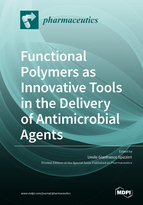Functional Polymers as Innovative Tools in the Delivery of Antimicrobial Agents
A special issue of Pharmaceutics (ISSN 1999-4923). This special issue belongs to the section "Drug Delivery and Controlled Release".
Deadline for manuscript submissions: closed (30 November 2021) | Viewed by 36325
Special Issue Editor
Interests: stimuli-responsive drug delivery systems; munti-functional hydrogels; antioxidant polymers
Special Issues, Collections and Topics in MDPI journals
Special Issue Information
Dear Colleagues,
Many infectious diseases are induced by omnipresent microorganisms, including bacteria, viruses, protozoa, fungi, and algae, and, consequently, are very common, accounting for a significant share of the global disease burden. Unfortunately, antimicrobial resistance, adverse effects, and the high cost of antimicrobials are crucial health challenges worldwide. One of the common efforts in addressing this issue lies in improving existing antimicrobial delivery systems. In this regard, biocompatible polymeric particles, entrapping these bioactive molecules, are capable of being released over a desired period of time, thereby decreasing the frequency of their administration. At the same time, these systems are able to protect antimicrobial drugs from degradation, enhancing their bioavailability. There are many forms of drug delivery systems based on physical interactions between the polymeric carrier and antimicrobial molecules, namely, nanoparticles and microparticles, capsules and fibres, tablets, pellets, hydrogels, sponges, and many others. They can be synthesized using both natural (gelatin, cellulose, pectin, dextran, or chitosan) and synthetic (silicone latex or acrylates) polymers. Additionally, polymeric devices that are able to undergo morphological modifications in response to an external stimulus (pH, temperature, magnetic field, and light) represent an innovative field in the delivery of antimicrobials. In the effort to further improve delivery device performance, a combination of two or more signals can be developed by incorporating different stimulae’s responsive elements into the same polymeric network. These smart polymeric materials lead to superior in vitro and/or in vivo therapeutic efficacy, with programmed site-specific features and remarkable potential for targeted therapy. This Special Issue welcomes any topics regarding recent progress in the synthesis and characterization of innovative functional polymers suitable as carriers of antimicrobials, to be employed in the pharmaceutical and biomedical fields.
Dr. Umile Gianfranco Spizzirri
Guest Editor
Manuscript Submission Information
Manuscripts should be submitted online at www.mdpi.com by registering and logging in to this website. Once you are registered, click here to go to the submission form. Manuscripts can be submitted until the deadline. All submissions that pass pre-check are peer-reviewed. Accepted papers will be published continuously in the journal (as soon as accepted) and will be listed together on the special issue website. Research articles, review articles as well as short communications are invited. For planned papers, a title and short abstract (about 100 words) can be sent to the Editorial Office for announcement on this website.
Submitted manuscripts should not have been published previously, nor be under consideration for publication elsewhere (except conference proceedings papers). All manuscripts are thoroughly refereed through a single-blind peer-review process. A guide for authors and other relevant information for submission of manuscripts is available on the Instructions for Authors page. Pharmaceutics is an international peer-reviewed open access monthly journal published by MDPI.
Please visit the Instructions for Authors page before submitting a manuscript. The Article Processing Charge (APC) for publication in this open access journal is 2900 CHF (Swiss Francs). Submitted papers should be well formatted and use good English. Authors may use MDPI's English editing service prior to publication or during author revisions.
Keywords
- Drug delivery systems
- Antimicrobial agents
- Polymeric carriers
- Site-specific release
- Smart polymers







